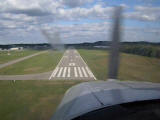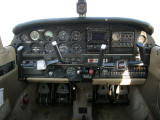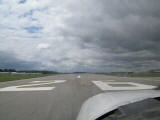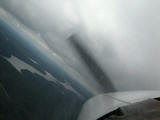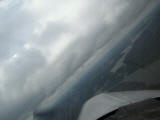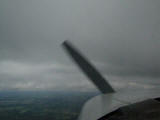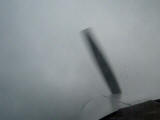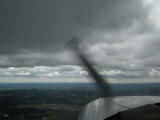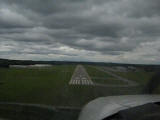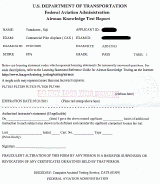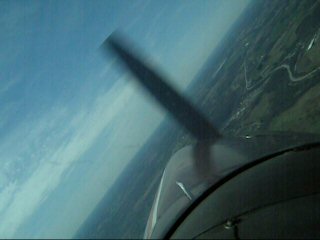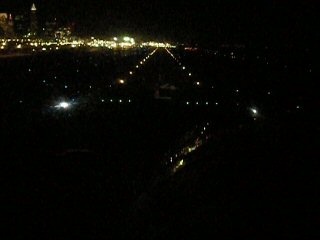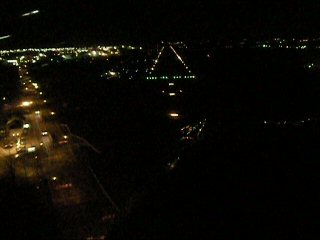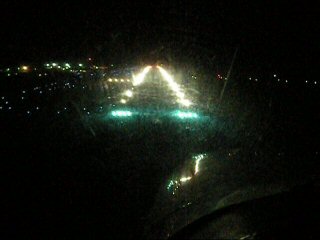Captain YS's Flight Log Book |
Previous Articles [2006 and before] [2007] [2008] |
|||||||||||||||||||||||||||||||||||||||||||||||||||||||||||||||||||||
[Click here for 2010 articles]
10/12/2009 Upgrading my Flight Recorder Whenever I go flying, I mount
my compact digital camera, Nikon Coolpix P50 For mounting a camera, I have tried a clump-pod before, which was successful, but it is somewhat obtrusive, and it could block view of an instructor when I fly dual. So, I fabricated a suction mount and have been using it for a while. Since I can put a suction mount on my side, the camera never blocks view of the instructor sitting on my right. But, I was getting a problem with the tripod head.
I just disassembled a tiny table-top tripod, and connected on top of
pieces of wood that is tied to my
Garmin Suction Cup Mount I ordered a better ball mount,
Slik SBH-100 Actually, I am also evaluating another suction mount,
Click N' Stick
10/26/2009 Flying over Salt Lake I visited Salt Lake City, UT, for October 25-28 for attending a conference called 18th International Meshing Roundtable. My presentation was scheduled for the morning of Monday October 26. I thought it would be nice if I rent a Cessna from a local flight school and go for a sight seeing tour over Salt Lake. I looked up on Airnav, and found Air Center of Salt Lake located on Salt Lake City 2 airport. I contacted the Air Center, and reserved a Cessna and an instructor. Salt Lake City's elevation was 4600ft, more than 3000ft higher than Pittsburgh. Also, the city was surrounded by the mountains. In addition, the majority of the city was covered by Salt Lake International class B airspace. To fly from Salt Lake City 2 to over the Salt Lake VFR required to fly through a narrow air space between the mountain and Salt Lake City class B. I may be able to get a class B clearance from the clearance delivery RCO of Salt Lake City 2 before taking off. Anyway, I was going to fly with an instructor. I was thinking to just ask him.
I left Pittsburgh on Sunday morning in United Airlines flight. I had to stop at Denver once to change an airplane. When I was in the airplane, the thought came to my mind. "I have my aviation GPS, Garmin 96c. How about trying to see if my Garmin 96c can lock on to the satellites from the passenger cabin?" I was sitting on the window side. I turned on my Garmin 96c and held against the window. It was able to lock on to bunch of GPS satellites, and showed that I was to the south west of Chicago. United Airlines offers the ATC communication on audio channel 9. I was watching my GPS, and tried to copy the instruction from the ATC. It was a little bit of IFR training. At Denver, I was supposed to change the airplane, but I didn't have to. They used the same airplane I was on from Pittsburgh for Salt Lake City. So, I had to leave the airplane once, but ended up with boarding the same airplane from the same gate. In Salt Lake City, I picked up a rental car and visited Hill Aerospace Museum next to the Hill Air Force Base. It was a nice small air museum. Some airplanes are left outside and rusting. But, I was able to take a picture of entire B-52. Usually this airplane is too big and usually clammed with other airplanes, and I cannot take a clear shot of the entire body. This museum was a rare museum that allows to capture entire B-52 in one picture. More photos will be uploaded to the airplane photo gallery. On Monday, I did my presentation with no problem. I had lunch hosted by the conference, and then drove to the Salt Lake City 2 airport. I had weather briefing before leaving the hotel. The forecast was predicting gusty wind, but the wind was supposed to be almost parallel to the runway. I had flown in even gustier condition. I should be able to take it. At the airport, I met with the instructor, and I was assigned to N516CS. It was interesting because I have flown N596CS from PFTC many times. The airplane I flew had only one digit difference in the tail number. I explained to him that I wanted to fly for sight-seeing, and I'd been flying from 1200ft-elevation airport with nearly flat terrain and was not familiar with flying in this type of terrain. Then we discussed where to go and got to the airplane. The wind was already picking up. AWOS was reporting 160 at 18 gusting 24. It was windy, nonetheless, it was almost parallel to the runway, as forecasted. I pre-flighted the airplane, and was ready to start the engine.
In the normal check list, I was supposed to use mixture full-rich for starting the engine. But, I was not sure if I should do the same because of the high elevation. I asked him, and he said just follow the check list. In two attempts, I was able to start the engine. I taxied up to the run-up area and followed the run-up and before-take-off check list. In Pittsburgh, I usually use mixture full-rich for take off, unless it is a hot summer day. But, here, although the air temperature was not so hot, I leaned the mixture to the peak RPM, then enriched about two twists. I was ready to take off! Another airplane was turning from downwind to final. So, I thought I should wait, but the instructor suggested I could go before he landed. I called on the radio "South Valley traffic, Cessna 516CS, taking off runway 16, right downwind departure to the north, South Valley." By the ways, south valley airport uses right traffic for runway 16 probably due to Salt Lake City class B airspace. I aligned with the runway and pushed the throttle forward. The airplane reached 60kt and lifted off the ground. I turned right for right-crosswind, then another right turn to join right downwind. I was flying along the mountain covering my left-hand side. I had to follow the side of the mountain to stay clear of class B airspace. The instructor told me to stop at 5800ft because the class B airspace starts at 6000ft. Soon, we cleared the 6000ft class-B ceiling and entered the area with 6500ft ceiling. I climbed up to 6300ft. Then, finally I climbed up to 7100ft. In fact, the airplane climbed so well. 7000ft was my highest altitude I have ever climbed in Cessna 172. It was when I flew for my solo cross-country to satisfy one of the requirement toward commercial-pilot certificate. That time, I remember my airplane didn't climb well. After 6000ft, I could only sustain 300ft/min. climb in the last a few hundreds feet. And, unless I was really paying attention to the altitude, the airplane soon wanted to go down. But, this time, although it was supposed to be the same Cessna, I was easily maintain 500ft/min climb. Maybe due to colder air. Or, maybe propeller pitch was adjusted for better climb. I still don't know exactly. I climbed to 7100ft. It renewed my altitude record in Cessna 172 by 100ft.
I followed the shore line of the lake, then circled around Stansbury island counter clock-wise so that I had a good view of the island. When I was almost completed the circle around the island, I saw a salt plant. It was ironic to me. The day before, I drove around to buy some table salt for mouth washing. I had problem in my tooth and had my primary dentist check it up. He said there was no problem and referred me to a root specialist. The root specialist also said there was no problem. So, although my tooth irritated me (no pain though), two dentists said there was no problem. With no other choice, I followed the suggestion of my primary dentist and was frequently mouth-washing with salt water. I needed some salt for that purpose. I could have carried some from my apartment, but I didn't want a security inspector see some white powder and take me to a different room for interrogation. But, it was so tough to find a grocery store in downtown Salt Lake City. I drove around maybe for an hour or so and finally found a Walmart and was able to buy some salt. But, from Cessna, I saw more than enough for life supply of salt underneath! I thought it was an irony (but funny).
Then I came back to the airport and did some touch & goes. In Pittsburgh, I push the mixture to full-rich during the pre-landing check. But, I was at about 6000ft. Mixture full-rich didn't seem to be right. I asked the instructor and he suggested to enrich by to twists. I followed his suggestion and twisted the mixture knob twice to the right. I was ready to go for touch & goes. Although the wind was supposed to be blowing from straight ahead, I was pushed very far to the left and overshot the runway a little bit. It was not too much. I was able to correct for the overshoot and made it to the runway. To compensate for the gusty wind, I thought it was a good idea to use partial (20 degree) flaps, and my instructor agreed on it. The first touch & go was very well. In the second one, I tried to turn to final a bit earlier not to overshoot, but it was not enough. In fact, I apparently was not taking enough crab angle on downwind. So, for the third one, which was a full-stop landing, I took more crab angle to the left on downwind, and it worked perfectly. I made a nice turn to final, and made a good landing. It was a great-fun 1.2 hours flight. I put U42, which is the airport identifier of Salt Lake City 2, on my logbook.
I stayed in Salt Lake City for another two days and came back to Pittsburgh. Return flight was, for some reason, in American Airlines via Chicago. I was watching my GPS occasionally in this flight, too. But, a cabin attendant noticed I was watching GPS and asked me to turn it off. I turned it off. I didn't fight with a cabin attendant to be on the next morning news. Airlines are operated under different regulations from private pilots. So, I cannot tell if it was Federal Aviation Regulation or American Airlines' policy. In United Airlines, I was told that "all electronic devices that transmits a radio wave are not allowed." No cabin attendant bothered to tell me to turn my GPS off. Obviously Garmin 96c is a receiver and does not transmit any radio wave. I use my Garmin 96c in my Cessna or Piper and does no harm. It rather helps my airplane navigate. I was on MD-80, a big airliner with much bigger com/nav antennas. I can guarantee you that Garmin 96c in the passenger cabin never interferes the radio communication or navigation. I could even offer my Garmin 96c to the flight crew in case of total electrical failure. Everyone knows that using cell phones in the cabin is nothing dangerous. I turn it off on board the airplane because FAA wants me to do so. But, no single airplane crashed because someone in the passenger cabin forgot turning a cell phone off. This regulation is such meaningless. If I experience total electricity loss while I am flying an airplane, I will not hesitate to use my cell-phone to call a flight service station for assistance. It will be safer and will give me better chance to bring my airplane back to the ground safely. Of course, if an electronic device emits radio wave like 121.1MHz or 110.0MHz, radio communication and VOR navigation will be screwed up. Those devices must be turned off. Actually, if you build and use your own transmitter that transmits on 121.1MHz, which is used by airplanes, you will be arrested. So, such a device should be turned off no matter where you are! But, it doesn't make sense to me to ban those electronic devices that do not emit radio waves on the airplanes. Most of the regulations are from real safety concern. But, some are, unfortunately, not. Maybe someone will lose money if people start using cell phones on the airplanes. If you are thinking that it would be safe if every suspicious thing is banned, you are utterly wrong. From engineering point of view, only necessary things should be banned as necessary. Excessive restriction only makes things less safe. A human does not have infinite attention. We need to 'pay' attention. In other words, we have limited attention that we can pay. It is unfortunate that cabin attendants needs to pay some attention to hunt electronic devices that does no harm to the airplane. The airplane will be obviously safer if the cabin attendants direct their attentions that are currently wasted for hunting those harmless electronic devices to other things that are really related to the safety.
10/20/2009 Amelia Earhart and Butler County Airport The movie "Amelia" will hit the theaters this weekend. The heroine of the movie, Amelia Earhart, apparently had a relation with the Butler County Airport, from which I flew for foliage-watching flight last weekend. According to the BTP News, October 2009 issue, (the first issue)
The runway that time should have been a grass runway (I guess), and it should have been different from runway 8/26 that I can use nowadays. But, I never imagined that I was taking off and land at such a historic airport where Amelia Earhart had her instrument training. There are bunch of aviation history all around the U.S. (Like, P-51 Mustang flying with other general aviation traffic.) I believe this aviation culture is the backbone of the strength of the American aviation and space industry. In summary, General Aviation Serves America! 10/18/2009 Flying over Red Carpet The time was perfect for foliage-watching flight. I took off with my wife and flew around Butler County airport in a Piper Warrior. It was a cold day, and I had tough time starting the engine. I expected I would need to prime more than a normal day. So, I pumped the primer six times. And, the engine never started. I was almost giving up when an instructor walked up and told me to use ten primes. Ten primes? If I do it in Cessna, I am pretty sure I will flood the engine. But, I tried ten primes, and it started. I learn a new thing every time.
The weather was constantly clearing up since Saturday. When I came to the airport, the airport was still covered by the overcast cloud, but the cloud was quickly breaking up. When I took off, I saw a lot of bright spots on the ground.
I took to the south first, and then headed north. Then I flew over Lake Arthur and came back. It was a 1.2-hour flight.
Actually, it was a busy day for me. After landing at Butler County airport, I drove to Allegheny County airport for my commercial training. Due to weather and some schedule problem, I was not able to practice commercial maneuvers for almost a month. And I was going to be out of town next week. If I missed this day, I wouldn't have flown for commercial training for more than 6 weeks. I was worried about forgetting things. So, I decided to fly double-header. Since I was flying Piper Warrior, which has trim wheel beside the pilot seat. I realize I was searching for the trim wheel beside the seat while I was flying Cessna 182RG, which has the trim wheel on the instrument panel. So, it took some time to recover feeling in Cessna 182RG, but I flew not too bad. And, the next day, Monday 19th. I flew an instrument training. I hadn't flown instrument practice for almost 3 months. I was expecting to screw up (that's why I need an instructor on board), but in fact, I did pretty good. I flew Localizer 27 approach to Washington County airport, then holding over Allegheny VOR, then VOR-A approach, and ILS 28 approaches to Allegheny County airport. Actually, while I was flying, I heard a P-51 Mustang approaching to Allegheny County airport. When I landed, I saw P-51 parked at Corporate Air. Corporate Air is a FBO (Fixed Base Operation) at Allegheny County. Apparently, this P-51 landed at Allegheny for re-fueling. I was watching it for a while. Then, it started the engine and took off to the next destination.
10/11/2009 First solo in 4 months! Finally, after four months of no solo, I flew solo in Piper Warrior! I took off from Butler County airport, then flew to Allegheny County. I did two touch and goes there, and came back to Butler. On the way back, I circled around an airport owned by a friend. The airport has a grass runway. Due to rental agreement, I am not allowed to land at a unpaved airport. So I just circled around it and took some photos. The airport is called NARDO airport, and the airport identifier is 77PA. However, it was not on the GPS database.
I wanted to do some more touch and goes at Butler to get used to the airport, but I was running out of time. I just made a full stop landing, and returned the airplane. I flew from Butler County Airport in Piper Warrior PA28-161 yesterday. I flew with an instructor, and the purpose of the flight was to get used to this airplane. The flight time was 1.1 hours, and which made my total flying hour to 300.1 hours! In fact, I have one extra hour which was written on a separate paper, so I have already achieved it, strictly speaking. But, now I have 300.1 hours logged on my logbook. This time, the flight went a lot smoother. The weather was nicer. And, I believe the instructor didn't even touch the yoke except when she checked push-to-talk button on her side. I wanted to make landing a little softer, but it was ok. In fact, Piper Warrior is an easier airplane to fly than Cessna, at least that's what I felt. It seems to me maneuverable, responsive in slow-speed range, and does not float on flare as much as Cessna. I couldn't believe steep turns were this easy. I was able to stay within plus-minus 50ft from the entry altitude during steep turns this time. Once I measured time after round out before actually touching down by looking at my cockpit video in Cessna, and it was floating 12 seconds with approach speed of 67kt on final. In Warrior, again from my cockpit video, it was like 8 seconds. Now I feel a lot more comfortable in Warrior. I'm thinking to go for solo in Warrior next time. As for my commercial training, I did all the maneuvers by now. I need to fly a few more times to brush up my maneuvers and then will go for check ride.
As I wrote before, PFTC no longer does airplane rental unless I have an instructor onboard. I was expecting them to restart rental soon, but despite my expectation, they still don't let me fly solo. When they were doing rental, virtualy all time slots of all Cessna 172 were taken for the weekends. But, now I see a lot of opening for Saturday and Sunday. I am worried if they are making enough profit to continue operation. For me, it's not a big deal when I fly for commercial training or my IFR training because I anyway ask an instructor to fly with me. But, what's inconvenient is I cannot fly by myself, and I cannot take my friends for fun ride. So, I decided to get checked out for rental from a different flight school. Air Quest Aviation is located at Butler County Airport (KBTP), which is about 50 minutes drive from my apartment. The main business of Air Quest is to provide services for an airplane flying in and out of Butler County Airport. But, it also operates a flight school. They have Piper Warrior (PA28-161), Cirrus SR-20, Cirrus SR-22, Cessna 150. Among them, Cessna 150 is the cheapest, but it can carry little load, so I asked them to check me out for Piper Warrior. On the day of check-out flight. They told me that it was going to be like a check ride for private pilot certificate. So, I studied materials (most of them were something I also was studying for my commercial certificate anyway). I also prepared for some instrument flying, too. But, it turned out a lot easier. I recently met with a friend who is working on his instrument rating from Air Quest aviation. He happened to fly earlier on the day with the same instructor who was to give me check out. And, he told him about me that I was working on my commercial and I have been flying out of Allegheny County airport. So, my instructor just asked me some questions, and said that I should know Federal Aviation Regulations and should have no problem dealing with ATCs. And, then we immediately headed to the airplane without any oral exams. That was easy. I have flown Piper Warrior about 10 years ago a few times. I also flew Piper Archer in Hawaii several times. Archer is something like a more powerful version of Warrior, and the interior should look similar. Nonetheless, I am not used to Warrior as much as Cessna and it took a while to do pre-flight inspection. I will get used to it. And, it looked like an old airplane, and marking on some switches were already rubbed away. Apparently I need to really look closely or may need to remember which switch is what. I was able to start an engine easily. I had to push like 0.5 inch throttle in Cessna, but I needed really slight in Warrior, maybe half of Cessna, to start an engine. While taxing, I had to use little differential brakes. Steering wheel was very effective. On engine run up, the instructor told me to use both parking brake and pedal brake. I never used parking brake in Cessna. I was curious if the pedal brakes were not effective enough. Honestly, I don't want to use parking brakes there because I don't want to forget releasing it and start take-off run.
I took off, and I immediately liked the view. It's a same sensation when I flew Diamond Eclipse, which is hospitalized due to prop damage, which made PFTC to cease airplane rental. I also felt it was more nimble than Cessna. Then I turned right and headed to Lake Arthur. The cloud was low. I hope I was really 500ft below the cloud. According to the weather report, I was suppose to be way below 500ft from the cloud. In fact, even when I feel the cloud to be very low at Allegheny, ATIS often says ceiling 800ft. So, maybe I really had more than 500ft below cloud.
I started with Steep turn. I had been doing it in Cessna 182RG, which was a heavy airplane. In Cessna 182RG, I had to pull the yoke very hard to maintain altitude, but it was so easy to do it in Warrior.
Then, I did slow flight, power-off stall, and power-on stall. Things went well.
After doing maneuvers, I headed back to the airport and did some touch and goes. I was so used to do touch & goes in a towered airport, so I was not sure if I was able to do radio communications all right, but in fact I did all right. The instructor told me that I was over-controlling on round out and flare. Maybe because Cessna gets really mushy before landing, if I move the yoke as much as I do in Cessna, it appeared an over control to the instructor. I will get used to it eventually.
So, I was checked out with little problem. I would not venture flying solo right away. I will fly with an instructor once or twice before actually go for solo. But, I liked the airplane, and I am looking forward to flying solo again. 07/07/2009 Commercial-Pilot Knowledge Test Passed! I have passed the Commercial-Pilot Knowledge Test with 95% accurate answer! I am another one step closer to my commercial-pilot certificate!
06/14/2009 Aerial-Photography Mission II Pittsburgh Japanese School is a school for Japanese students who are living in Pittsburgh. And, this school held an athletic meet on June 14. I was asked to fly over the scene and take aerial photography of the event. I drove to the location ahead of time, and recorded the coordinate on my portable aviation GPS, and flew two practice flights earlier. In the morning of the day of the event, the sky was clear and the forecast was calling for a nice calm wind. It was a perfect condition for the aerial-photography flight. However, I received a phone call from Pittsburgh Flight Training Center (PFTC). I really had a bad feeling when I took a phone. The phone call from the flight school on the day of the flight usually means the airplane is down for maintenance. It was Sunday, and all other airplanes were booked. If I could not use the one I reserved, I had no choice but canceling the flight. But, the phone was not to tell that the airplane was down for maintenance. Instead, they told me that PFTC would no longer rent an airplane. In other words, unless an instructor was on board, I could not rent an airplane from PFTC any more. But, on this day, an instructor who had flown with me several times (and in fact who gave me one of the stage checks for my instrument rating) was available. So, I asked him to fly with me. Honestly, having an instructor on board made the mission easier. I was able to ask him to look outside while I was circling around the scene so that I was able to concentrate on staying constant distance from the scene. I came to PFTC at noon. I explained the instructor about the purpose, destination, obstructions around the destination. I also told him that they will assemble human letters at 1pm, and we wanted to leave at 12:40 or so to reach there at 1pm. Then I called a person at the scene and told we were going to fly as scheduled. I did pre-flight inspection, and we were all set.
I started the engine at 12:40, and took off almost as planned, and headed north. I didn't check my watch, but I was able to clearly see human letters "PJS" which stood for Pittsburgh Japanese School, on the field. My mission was to circle around the letters five times, while my wife in the back seat was taking pictures. In the practice flights, I had to watch outside, pay attention to the instruments, and keep constant distance from the field. But, this time the instructor was watching outside. My work load was reduced substantially. It was just like flying a maneuver that I have practiced during my private pilot training. So, success of the mission was on my wife's shoulder. Taking pictures from inside a small airplane is not so easy. First of all, the airplane is shaken by turbulence. The air on this day was smooth in general, but the sun was warming up the ground and making the air turbulent little by little. Also, you cannot hold a camera with best posture in such a limited space. If you are on the ground, you can stand stably, hold the camera with your best posture. But, in the back seat of Cessna 172 with seat belt on, you need to twist your body to aim at the target. So, you need to hold a camera with far-from-ideal posture. But, my wife took some nice pictures with the longest zoom position (250mm). The mission was accomplished! Actually, all I did was flying around the target point. My wife did a good job in taking nice pictures. The ground staff who assembled the human letters did a good job, too. Basically, any successful mission is a result of a team work. Later, the students of the Pittsburgh Japanese School presented us a nice commemorative gift with thank-you messages. I didn't remember any occasion that I have been so much appreciated for flying. If I have chance, I will be happy to fly for another aerial-photography mission. 05/24/2009 One step closer to the commercial pilot certificate One of the main points of commercial pilot training is to get used to a complex and high-performance airplane. An easy explanation a complex and high-performance airplane is that a complex airplane is an airplane with retractable landing gears, and a high-performance airplane is an airplane with a high-power engine and/or a constant-speed propeller. So, during the course of the training, I receive complex and high-performance endorsement. The instructor gives me training on a complex and high-performance airplane and endorses on my logbook that I am proficient in the complex and high-performance airplane. Today I finished my fifth training, and received the endorsements. I thought now I could rent a Cessna 182RG from PFTC and fly by myself, but they apparently changed the rule and do not rent an airplane, so the airplane is for dual training only. I guess they rent an airplane to the instructors, but not for a private pilot apparently. So, now I am legally fly a complex and high-performance airplane, but probably I will not have an opportunity to fly solo in a complex and high-performance airplane for a while. Nonetheless, I am one step closer to the commercial pilot certificate. Actually, in the past four trainings, I had tough time starting an engine. For me, the most difficult thing to do in this airplane was not maneuvers or landings, but starting an engine. But, today I was able to start it by myself. But, I don't understand why this engine does not start easily if I follow the instruction on the manual. But, today, landings were not so satisfactory. In most cases, I was too high on final. I believe I was applying too much power after I began descend. In Cessna 182RG, I look at the manifold pressure to adjust throttle, and I was reducing it to 15 inch (HG). On base leg, I had to pull the nose up to reduce speed, and I noticed the vertical speed indicator was showing almost 0ft/min until the airplane slowed down and I lowered the flaps to 20 degrees. It implies that I should have reduced power to 13 inch or so, but I hesitated to do so because when I reduced power at the end of downwind leg, I heard some puffing noise from the engine and felt vibration. So, I kept the manifold pressure at 15 inch. After landing, I asked about the noise to my instructor, but he said he didn't feel anything unusual. I guess the noise and vibration was just normal. Next time, I will try 13 inch when I begin descend. By the way, below pictures are Cessna 182RG that I am flying for my commercial training. (Click to enlarge)
04/25/2009 Aerial Photography Mission There is a non-profit organization called "Pittsburgh Sakura Project." Sakura means a cherry tree in Japanese. The organization is driven by some Japanese living in Pittsburgh, and the goal is to make a place that everyone can enjoy cherry blossoms in spring, just like Washington D.C. This year, the organization held the first planting ceremony and planted about 40 cherry trees in North Park near Wexford, about 10 miles north of Pittsburgh. I volunteered to fly for taking aerial photography of the planting ceremony. I flew two practice flights. The elevation of North Park is about 1,000ft, but the park is surrounded by the hills rise up to 1,200 to 1,300ft. There was a tower on the south of the park, however, as long as I stay north east side of the park, it was not an issue. In the first practice run, I maintained 2,500ft to be safe. I flew at 110kt, which is a normal cruising speed of Cessna 172. I didn't reduce speed to the maneuvering speed because I had no intention to make a steep turn. However, it was too fast and too high. In the second practice, I tried to fly at 2,300ft over the park, and 2,500ft over the hill side. So, I repeated descending and climbing turns. I also used 10 degrees flaps to reduce speed to 80 to 90kt, which is well faster than the stall speed of Cessna 172. This worked ok. My wife sitting in my co-pilot seat was able to take many nice pictures of the area where the ceremony was going to be held. Another concern was airplane availability. I reserved N9417L, which came out of 100-hour inspection early this month. It made sure the airplane would not be down for the maintenance on the day of the ceremony. But, the airplane was down for maintenance last weekend. That worried me a bit because all the airplanes are usually reserved for the weekend, and it is difficult to switch to another airplane if the reserved one is down for maintenance. Nonetheless, it was up and running by later of the week. The forecast was predicting a clear sky. There seemed to be no problem for the flight. However, yesterday, the forecast was predicting wind 22012G25, meaning wind from 220 and wind speed 12kt to 25kt. Sixty degrees off from the Allegheny County runway at 25kt wind gives 21kt cross-wind component. I was becoming confident in dealing with cross wind. But, 21kt cross wind is way too much. It exceeds the demonstrated cross-wind component of Cessna 172 by 6kt. So, I told the person who was organizing the ceremony that there was a high likelihood that I was not able to fly. In the morning, the forecast changed to 22012G18. Slightly better than the forecast from yesterday. But, maximum cross-wind component was slightly greater than 15kt. It contradicted with other commercial weather forecasts, which were predicting West-South-West wind. So, there was a hope that the wind direction could become more parallel to the runway. I postponed the final decision on go or no go until last minute, and headed to the airport. When I left my apartment, the observed wind was from 230. Fifty degrees off. Not as bad as sixty degrees off. And, at the airport, ATIS was reporting 260 at 15 (I don't remember exactly, but something like that.) It is windy, but just 20 degrees off. I decided to go. By the time I started the engine, the wind had changed to 280 at 15, almost parallel to the runway. The wind finally cooperated. I took off and headed to the North Park with my wife, as an aerial photographer, in the co-pilot seat. It was a short flight. We reached over the area in 10 minutes after take off. We could see large "SAKURA '09" on the ground. We made four to five 360s and took over 100 pictures. The air was not smooth. From a shaking airplane, taking continuous shots with fast shutter speed is the only way to get some nice pictures, and it worked!
Then I came back to Allegheny County airport. The wind was 250 at 24. Very windy, with 12kt cross-wind component. But, I didn't feel that after all. Actual wind seemed to be blowing perfectly parallel to the runway. This time I didn't forget checking gear down upon pre-landing check, and on base leg. The tower told me to join right base 28, so there was no downwind. When I turned final, the airplane refused to descend. On base leg, the airplane was nicely descending at 500 ft/minute with 1,700RPM. But, when I turned final, the vertical speed indicator showed almost 0 ft/minute. I reduced throttle to 1,500RPM. But, the airplane didn't descend. I didn't want to use full flaps due to the wind, but I had to use full flap this time, and had to pull the throttle to idle. That was a very steep approach. Maybe it was due to the strong head wind. Head wind makes approach steeper. And, I totally forgot checking gear down on final. I guess I need more practice.... I believe the some of the pictures will be posted on the Pittsburgh Sakura project web site. The plan is to take aerial photo every year so that we can see the progress of Sakura planting. I am looking forward to seeing cherry trees in full bloom from the air next year. By the way, Pittsburgh Sakura project is accepting donations. Please see the instruction on the project web site.
04/11/2009 Nice Cross-Wind Landing (Almost) I took two visitors from Japan for a sight-seeing flight. The forecast from the day before was predicting strong northerly wind, 36012 (12kt wind from 360 degree heading.) Cessna 172 was tested for 15kt cross-wind landing. But, it's not the limitation. It could tolerate stronger cross wind. Nonetheless, it would be very difficult. I personally had landed with 15kt cross-wind before. That time, the weather briefer was predicting calm wind. I flew to Franklin and came back, and ended up with dealing with 15kt cross-wind from south. So, I was pretty confident to deal with 12kt cross wind. Actually, Allegheny County airport has a sub-runway, 13-31. If I use runway 31, I would have just about 10kt cross wind. Nonetheless, if the wind blew too much stronger than the forecast, I was thinking to cancel the flight. I woke up at 7am, and looked at the forecast, which gave me a surprise. It was predicting 35012G20, meaning 12kt wind from 350 heading with peak gust at 20kt. Even if I use runway 31, peak gust would give me 13kt cross wind. I though I probably would be ok. But, I would make the final decision at the airport. So, I picked up the visitors and headed to the airport. When we arrived at the airport, the wind was 360 at 12. Not bad. Other airplane were apparently also flying. So, I decided to go. I strapped in Cessna 172, N596CS, and took off. I flew a regular sight-seeing course. I flew over Lake Arthur and came back. When I came to about 10 miles north of the airport, ATIS was reporting 36012G18. Gusty wind was taking shape. But, it's slightly better than 36012G20. I was expecting that the tower would give me runway 31. But, the tower actually told me to join right base runway 28. It would be interesting if I suddenly receive 18kt gusty wind from the right while I was flaring over runway 28. I thought about asking runway 31, but the tower soon changed the clearance and told me to join right downwind runway 31. Thank you, ATC! So, cross-wind component about 10kt with strong head wind. Haven't we heard about it somewhere? It was exactly the condition I mentioned in the previous article that could make a gear-up landing more likely. Cessna 172 doesn't have a retractable landing gear. So, I do not need to be worried about the gear-up landing. Nonetheless, I was trying to call out "Landing Gear Down" upon pre-landing check, and check gear down on downwind, base, and final legs. Above the Water Front shopping mall (near my apartment), I performed pre-landing check, and called "Landing Gear Down." I certainly did that. I remembered I looked at the landing gear. Then, I began descend and soon joined right downwind runway 31. The wind was pushing me from the left. So, I swung my heading to the left to counter the wind and flew parallel to the runway. I lowered flaps to 10 degrees and began descend only to be told by the tower to stay on downwind for a while. I climbed back up to the traffic-pattern altitude and waited until the tower clears me to turn base. I turned to base when the tower cleared me to do so and lowered the flaps to 20 degrees. I didn't use any more flaps due to cross-wind. Then, I turned to final. Because of the tail wind on downwind, I was pretty far away from the runway. As I expected, my airplane was pushed from the right. I banked my airplane to the right and pushed left rudder to establish wing-low attitude. When I found the correct bank angle and rudder pressure that maintained the airplane heading parallel to the runway and kept the course straight to the runway, I felt I got it. On final, the tower updated the wind, and it was 36014. Gust factor was apparently gone, but it could come back any time.. I maintained 5 to 10kt faster speed to prepare for the change of wind speed. Then, I rounded out and flare. I clearly felt my right landing gear touched the ground first, then left landing gear. Wow! It was a perfect cross-wind landing! My years of training paid off! ........ Did I check gear down on downwind, base, and final? (No, I didn't.) Of course, I called out "Landing Gear Down" upon pre-landing check. So, even if I were flying C182RG, I wouldn't have ended up with gear-up landing. Also, I checked with the video that I had about 10 seconds or so after I pulled the throttle back to idle before I heard the stall-warning horn. So, I should have been hearing gear-warning horn for almost 10 seconds. If I recognize the gear-warning, I should have been able to go around. Nonetheless, I was totally forgetting about the landing gear when I should have checked gear down. I guess I need more training to fly Cessna 182 RG solo..... 04/05/2009 Commercial Training #1 I have started my commercial training! The first step is to become familiar with Cessna 182RG. After several minutes of briefing, I strapped in N6149S. This airplane had two major differences from Cessna 172, constant-speed propeller and retractable landing gear. In Cessna 172, I adjust throttle by looking at tachometer (RPM). However, in Cessna 182, I look at manifold pressure gauge when I adjust throttle. Engine RPM is controlled by a blue knob, which we simply call it "prop". For example, during the pre-landing check, we call "prop push in" meaning push the blue knob all the way in. That makes the propeller pitch in high-RPM position. But, the adjustment works upper and lower limit. Like, when the airplane is at low speed, adding throttle increases the RPM. Here was my first confusion. The take-off check list said (1) Full-throttle, then (2) 2,400 RPM. Should I push the throttle all the way in? Or, should I add throttle up to 2,400 RPM? The answer was, push the throttle all the way in, then climb up to 500ft AGL, then reduce throttle so that manifold pressure within green arc, then adjust propeller to 2,200 to 2,400RPM. (How can I get that from the check list?) Anyways, I understood that. Then, we took to the air.
We headed to the practice area to do some maneuvers. I haven't practiced maneuvers for a while. My main focus on training was to be a better IFR pilot. We started with slow flight, then power-off stall. Man, the feeling of stall was a lot clearer in Cessna 182 than Cessna 172 (than Cessna 150.) Actually, when I was doing my private training Cessna 150, one of the problems was I didn't feel stall. To perform stall recovery, I reduced throttle, slowed down, waited several seconds, then recover. My instructor said, it was more like a imminent stall, but I really couldn't feel it. But, in Cessna 182, I felt the airplane start falling. To me, it was easier to do stall recovery in Cessna 182. Then practiced power-on stall, then steep turns. For private certificate, the steep turn meant 45 degree bank. This time, I used 50 degree bank. First try was not so good, I lost 100ft or so. But, the second try went a lot better. Then, we came back and practiced five touch & goes before making a full stop. I didn't screw up. I thought I did better for the first time. By the way, I now understand why gear-up landing accident are not eradicated. If you think a pilot does gear-up landing due to the pilot's stupidity, you go home. A human is a creature that makes mistakes. The system as a whole must prevent a human error from becoming a catastrophic failure. Cessna 182RG has a landing-gear warning horn, which sounds just like stall-warning horn. So, if I forget lowering the landing gear, I will hear the warning horn, and then I can go around or lower the gear if I have time. According to Cessna 182RG manual, landing-gear warning horn goes off if the landing gear is not down and (1) manifold pressure is reduced to about 12 inch, or (2) flaps is lowered about 25 degrees. So, does it really help? In the training, I lower the landing gear on downwind leg, check gear down on base leg, and on final. So, I will have three chances to lower landing gears. What if the air traffic controller wants me to do straight-in landing? First two chances are lost. I have only one chance to lower the gear. I am just about to lower the landing gears, when the ATC reported another airplane flying nearby. I need to find the airplane to avoid collision. My attention was drifted from the landing gear to the nearby traffic. I easily forget lowering the landing gear. When I begin descend, I reduce the manifold pressure to about 15 inch, which does not make the horn go off. Let's say, I choose partial-flap landing due to strong cross-wind. I use flaps no more than 20 degrees. Flaps do not ring the horn, either. With a strong cross wind, I need to concentrate on maintaining the approach course more than usual. I will have less chance to notice my landing gear is up. The last hope is, with landing gears up, the airplane does not decelerate or descend as much as I want, so I may end up with reducing the throttle and hit 12 inch manifold pressure. Or, if I am unlucky enough, I do not have to reduce power to stay on the glide path because of head wind. I may end up with coming close to the runway with gears up. At last moment, I pull the throttle to idle for round out and flare, finally the gear-warning horn goes off! Sadly, the gear-warning horn sounds just like a stall-warning horn, although they are different tones. It is normal to hear stall-warning horn during flare. Probably, I will not be able to distinguish stall-warning horn and gear-warning horn at that moment, and I will feel nothing unusual. So, I say Cessna 182RG's gear-warning mechanism is flawed. The gear-warning horn should sound totally different from stall-warning horn. And the manifold-pressure threshold should be somewhere like 15 inch and flap threshold should be 15 degrees or so (so that stall-warning horn and gear-warning horn are less likely to go off simultaneously). This airplane was designed and manufactured in early 1980s. I suppose the human-factor research was pre-mature then. By the way, below are the sounds of stall-warning horn and gear-warning horn.
Anyways, I cannot count on this gear-warning horn of Cessna 182RG. I apparently need to rely on solid training to prevent a gear-up landing. I should probably make my own rule to prevent gear-up landing in this airplane, like never make a straight-in landing so that I always have more than one chance to check landing-gear. Maybe I should lower the flaps to 25 degree instead of 20 degree on base so that the gear-up warning goes off. I also try to remember the tones of the two warning horns. Good news is, gear-up landing rarely causes an injury or fatality. Next commercial training will be in two weeks.
04/01/2009 Going for Commercial! To acquire a commercial pilot certificate, I need to satisfy certain experience requirements. One of them is total flying hours. I need to have 250 hours to go for commercial, which I have reached last year. Another requirement is night landing experience, which I have done more than enough. Probably the biggest one is the long cross country. I need to fly to an airport which is more than straight-line distance of 250nm away from the originating airport with landing at three different airports. I flew to Williamsport, Griffiss, and Elmira last September to satisfy this requirement. I also need to fly two VFR short cross-country (100nm, 2 hours) flights with an instructor on board, once during day and once at night. I happened to have flown to Ohio State University airport with my instructor. The return flight was partially night, but thanks to the strong head wind, outbound leg (AGC to OSU) took more than two hours. That qualify for day, VFR, dual (dual means instructor on board), short cross country. The last remaining requirement was night, VFR, dual, short cross country. To finish this last requirement, I flew to Cleveland Burke Lakefront airport. Due to summer time, the sunset time was 7:45pm. To make it absolutely night, we needed to wait until 8:45pm. Strictly speaking, if I take off after the civil twilight, the flight qualifies as a night flight. But, I just wanted to make it absolutely night. We took off almost exactly at 8:45pm and headed to Burke Lakefront airport. The airspace was very quiet. Almost as soon as we took off, we are cleared for Pittsburgh class B airspace, and headed directly to Burke Lakefront airport.
We flew with VFR flight following service, means an ATC was monitoring our airplane by radar. Pittsburgh approach handed us off to Akron-Canton approach, then to Cleveland approach. Cleveland approach gave us heading 300. Actually, it's dangerous to presume the next ATC direction. I always trying not to, but I often end up doing that. This time I was expecting a right turn to head to left base 24L or 24R of Lakefront airport. So, I thought Cleveland approach gave us heading 360, which is closer to the course I was imagining. My instructor immediately corrected me, so I made a left turn to heading 300. But, this course guided us away from Lakefront airport. Why 300? Apparently, the ATC was thinking we were heading to Cleveland Hopkins International airport. The ATC later asked us which of Hopkins or Lakefront we were heading. Anyway, we had to keep 300 heading quite long. Then Cleveland approach finally told us to make a right turn to head to Lakefront. I knew roughly where the airport was located. From my location, it was right of the downtown buildings. However, the rotating beacon, which helps finding an airport at night and in a low-visibility condition, of Lakefront airport was out of service. I needed to look for the runway lights. Runway lights are most visible from the final approach course. But, it's dark and not so visible from the side of the runway. I finally recognized the runway lights of Lakefront airport when we came to almost 4 miles from the airport. I told the ATC that we had airport insight. The ATC almost immediately told us to contact Lakefront tower. Then it got suddenly busy. I had to quickly descend to the traffic pattern altitude and set up for landing. and then I had to turn to final soon. The tower cleared us for touch & go, and told us to make a right turn after touch & go. So, I did one touch & go, then made a right turn. Due to the proximity to the downtown Cleveland, an airplane taking off from runway 24L/R of Lakefront airport needs to make a right turn. So, I did. But, there was nothing but Lake Erie on the right. I was expecting to see some city light or something over the horizon, which was not the case. When I turned cross wind, I saw nothing. Absolutely nothing outside. It's instrumental! I tried to transition to flying with instruments, but, at that exact moment, Lakefront tower gave us a new heading, altitude, and squawk code. Actually, switching from visual flight to instrumental flight takes tremendous concentration. It was impossible for me to remember everything at that moment. I should have told him like "Cessna 6CS, stand by," and asked the clearance after establishing the instrumental flight. But, since I was able to copy only transponder code. I asked the tower to give us everything except transponder code again, which made him apparently confused. I guess he wanted us to get the clearance from Cleveland approach. So, he told us to contact Cleveland approach. By that time, I was on the downwind leg and was able to see city lights. We contacted Cleveland approach, and got new heading, altitude, and transponder code with no problem.
We had a strong tail wind during the return flight. The GPS unit was indicating that we had 130kt ground speed while the airspeed was about 112kt. (Means we had a strong head wind from AGC to BKL) Since it took about 1.4 hours from AGC to BKL, it was obvious that I would have 2 hours when I come back to AGC. Ideally, I wanted to make it exactly 2 hours because 0.1 hour costs roughly $15. I hoped Pittsburgh approach to clear us for class B and straight course to AGC. But, two airplanes were approaching Pittsburgh international when we came back. So, we had to turn left to maintain safe distance. The return flight ended up taking about 1 hour. The total flying time of round trip was 2.4 hours. With this flight, I satisfied all the experience requirement for the commercial certificate. I am going to do at least 10 hours of training in Cessna 182 RG (RG stands for retractable landing gear). 10 hours is the minimum. I expect 12 to 15 hours for me. I'm hoping to get my commercial certificate by late summer.
We call a night landing to a not-so-well-lit airport as "Black hole landing". In such a circumstance, all you can see from the cockpit is runway lights. It gives you an illusion that makes you feel as if there were no runway surface and you could sink indefinitely. When you land at night, the runway light appears to be higher than actual. (In fact, runway lights are actually elevated by half a foot or so, I guess.) So, a pilot tends to round out and flare at higher altitude, ending up with slamming the airplane on the runway from that height. It's such a basic thing explained in a private-pilot text book. I personally am confident in night flying. I flew at night very often through my instrument training, and I frequently practice night landings. However, honestly, I have never really felt that illusion of "Black hole" - until I landed at Franklin Venango regional airport at dark night. On that day, I had an important visitor from Japan, and I decided to take him for a sight-seeing flight after the meeting. The meeting was over at around 5:30pm, and we came to the airport at 6pm. I pre-flighted and took off at 6:20 or so. The sunset time at Pittsburgh was about 6pm, and soon it became dark. Not to worry. I am instrument rated. I requested flight following and flew to Franklin Venango regional airport.
Pittsburgh approach handed me off to Youngstown approach, and soon I spotted the blue and white rotating beacon of Franklin. I was at 3500ft, which was too low for Youngstown approach to see my airplane on the radar. So, the radar service was terminated, and I switched the frequency to the Franklin UNICOM/CTAF. I asked Franklin UNICOM if the restaurant on the field was open. I was thinking to do just one touch & go and head back to Allegheny if the restaurant was closed, but UNICOM said it was open. I decided to land and eat there. I joined downwind nicely, turned to base, then final. It was DARK! Really DARK! All I could see was runway light. No runway centerline or nothing else. I realized that Allegheny County is somewhat bright even at night. There is a big shopping mall (Century III Mall) right next to the airport, and there are city lights along the roads surrounding the airport. Allegheny County is not quite a black hole. Maybe a white dwarf or a neutron star (?) But, Franklin was a true black hole. I finally knew what's real black hole approach is. Nonetheless, I was making a steady descend to the runway. I used my best judgment to see the height from the runway and rounded out. As soon as I rounded out, landing light of my Cessna, which was mounted on the main wing, lit the runway surface and I saw the centerline. What a relief! But, as the speed decelerated, and the nose comes higher, the landing light was not so directly lighting the runway surface, and engine cowling blocked my view, and I lost sight of centerline again. I relied only on the runway light. Then I heard stall horn. I hoped the airplane touched the ground soon, but it sank. It sank twice longer than usual, at least that's what I felt. Despite the long sinking, the airplane landed on the ground softly. I was drifted to the right by three to six feet though because I could not see the centerline. I reviewed the video after I came home, and it was not too bad after all. When I was a student, I would have been quite satisfied with that landing. I have slightly higher standard than that time. We had dinner there, and when I left the terminal, a twin-engine Continental airline turboprop came to the airport. It didn't even stopped the engine. The unloaded passengers and left the airport quickly. I came back to Allegheny, and indeed I realized Allegheny County is a well-lit airport. It was a good experience after all. I will eventually get used to black-hole landing after more practices. 02/01/2009 Flying in the Super-Bowl night As you all know, Super Bowl XLIII was held on Sunday. This year, Pittsburgh Steelers was in the Super Bowl, and virtually everyone in Pittsburgh was looking forward to the game. On the Super Bowl day, I took my wife and her friend, who was going to leave Pittsburgh and coming back to Japan soon, to a sight-seeing flight. Actually, I originally scheduled a flight on the day before, but the reserved airplane was down for maintenance, and I was not able to fly despite the nearly perfect weather. So, I postponed to the next day, which happened to be the Super-Bowl day.
I took off and flew to Lake Arthur. It was a sort of standard sight-seeing course I use. The surface of Lake Arthur was totally frozen, and I saw some people walking on the frozen lake. I hoped they didn't step on a thin ice and fell to the ice-cold water.
Then we came back and had dinner together at a nearby Applebee's. The Super Bowl XLIII started while we were in the restaurant. We watched TV until Steelers got 3 points and left the restaurant. When I walked out of Applebee's, the sky was still clear. The wind almost died down. It seemed to me a perfect condition to go for night-landing practice. My wife wanted to buy some stuffs from Target, so I left her at Target in Century III mall, and drove back to the airport. I quickly performed pre-flight, started engine, took off and did two stop & goes, and then landed. The flight took only 0.4 hours. That gave me three night take offs and three full-stop night landings, which is required to get night current. I can carry passengers at night for the next 90 days. No one else was flying in the pattern, but someone (I thought it was a medievac helicopter) was asking tower how the Super-Bowl game was going while I was flying. After that, I picked up my wife and came back home and turned on the TV. The remaining time of the Super-Bowl game was about five minutes or so. Actually, I and my wife do not know the rule of American Football. Only we knew was that the players needed to carry the ball forward. But, we at least could read the score. So, we decided to watch the game to the end. When we turned on the TV, Steelers were leading Cardinals by 20 : 7. We thought it was a safe lead. If you watched the game, you should know what happened after that. Cardinals finally took a lead when only 3 minutes left. Well, at that time, we thought our home team lost the game. Then came the dramatic touch down pass at 35 seconds remaining. Despite no knowledge of the game rule, we were pretty much excited by the dramatic ending of the game. We ended up with watching the most exciting part of the game. When the game was concluded with Steelers' victory, I heard shouts from other apartments. Cars were honking and waving Terrible Towel from the window. Pittsburgh was really exploded with cheer. At least three helicopters were hovering over the city broadcasting the crowd celebrating the victory of the home team.
01/17/2009 First Flight of the Year My first-of-the-year flight scheduled for January 10 was spoiled by the weather. I tried also 11th as well, but again the weather blocked it. I finally was able to fly today, January 17th. Although the ceiling and visibility recovered, temperature didn't. ATIS was reporting temperature -17C (-2F). When the air temperature is too cold, I need to apply engine pre-heater before starting engine. If there was frost or ice on the wings, I need to move airplane into the hanger to defrost. Before that, pushing or pulling the airplane on the icy ramp in a freezing temperature is such a pain. Well, the airplane may be welded on the ramp with ice. I was worried about those things, but the airplane turned out to be kept in the hanger. So, I was able to comfortably pre-flight, pull it out, and start the engine.
Since I couldn't fly while I was in Japan in December. I hadn't flown for about a month and half. I just wanted to refresh my flying skill again. So, I just practiced touch & goes. According to ATIS, wind was variable at 5kt. But, as soon as I took off, I felt strong wind from south. In such a cold day (I should say, an unbelievably cold day), engine performance increases and wings produce more lift due to high air density. As a result, the airplane climbs incredibly fast. Well, actually, "wings produce more lift" is a sort of tricky expression because both lift and drag forces are proportional to the air density. Nonetheless, while for the same air density, lift force is almost proportional to the angle of attack (AOA), drag force increases non-linearly as the AOA increases. It's something like drag force is roughly proportional to AOA squared. Of course, actual drag-AOA function is more complex though. I need a certain amount of lift force to maintain a certain climb ratio. But, since air density is high, an airplane needs smaller AOA to achieve the required lift. Then, since drag decreases quicker than lift as AOA decreases, the airplane can maintain faster speed. In other words, I can increase the AOA more without losing air speed beyond the climb speed, and the airplane climb faster as a result. Today, I pulled the nose up to keep the air speed at 75kt, which is a proper climb speed, and the nose was very high compared to a normal day. After enjoying an unlikely-steep climb of my Cessna, I made a left traffic pattern and turned to final runway 28. It was a nice cross-wind landing practice, cross wind from the left. Despite several weeks of no flying, I was able to make a pretty nice and smooth landing. After three or four touch & goes, the tower changed the runway from 28 to 10. I was told to make right traffic 28, and then make a left turn from the downwind to join left traffic 10. I flew accordingly, and this gave me opportunity to practice cross-wind from the right. For the last several landings, in particular, I clearly felt that the upwind-side gear touched on the runway before the downwind-side gear. I believe those were really flawless landings.
I have two goals this year:
I will continue training toward these two goals. I also have a smaller goal, which is to get used to Diamond DA20 Eclipse. But, only one DA20 of PFTC, N166SE, was grounded for maintenance. It's not difficult to fix the problem, but DA20 is the least utilized airplane of PFTC, so they don't work on it with priority. Maybe my smaller goal will be achieved after the two big goals. Happy new year! Should the weather permit, my first flight of the year will be on Saturday January 10. Click here for 2008 articles.
|
|||||||||||||||||||||||||||||||||||||||||||||||||||||||||||||||||||||
Previous Articles [2006 and before] [2007] [2008] |
| Comments are welcome.
Send E-Mail to:
|
